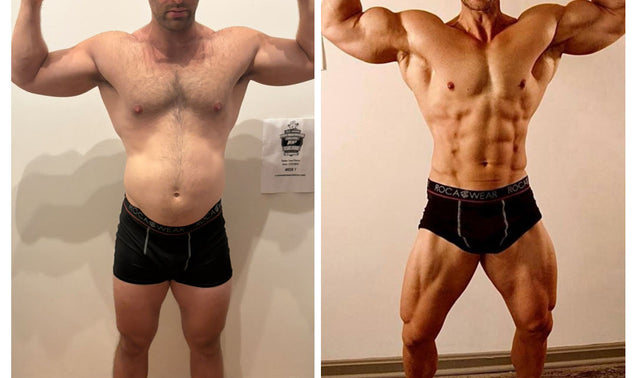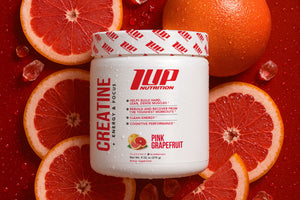Looking to shed unwanted pounds, sculpt a lean physique, and transform your body inside and out?
You’re not alone.
Millions of individuals each year seek the same goals, too. If you’re looking for the best diet to lose fat and reveal all that hard work you’ve put in at the gym, then it’s time to learn about how to build a cutting diet.
What is a Cutting Diet?
A cutting diet is a reduced calorie diet to help you shed body fat while retaining lean, toned muscle. In other words, a cutting diet is a fat loss diet.
This is different from the fad diets (“weight loss diet”) splattered across most magazines (e.g. “lose weight fast”, “shed 10 pounds in 10 days”, etc.) These sort of fad diets prioritize weight loss by placing individuals on extreme (read: unsustainable) diets that technically help you lose “weight”, but it’s a mixture of water weight, fat, and muscle.
Cutting diets prioritize fat loss by maintaining a higher protein intake while trimming away carbohydrates and fat. This provides your body with the essential materials (protein and essential amino acids/BCAAs) it needs to repair and maintain lean muscle tissue while creating the calorie deficit required to burn body fat.
How Many Calories Should I Eat on a Cutting Diet?
How many calories you need to lose weight depends on a variety of factors, including:
- Current body weight / body fat percentage
- Height
- Activity Level (both daily exercise and non-exercise activity)
- Age
- How quickly/aggressively you want to cut
Generally speaking, a 10-20% deficit below maintenance calories is needed to facilitate fat loss. For example, if your current maintenance calorie level is 2400 calories, then you would subtract between 240-480 calories per day (10-20% of 2400 calories) from your intake.
If you’d like help estimating your calorie needs for cutting, we’ll help you! Just download the 1UP Fitness App, answer a few questions, and you’ll be able to figure out how many calories you need for your goals.
What Are Cutting Diet Macros?
As we mentioned above, a cutting diet is a higher protein diet than typical weight loss diets since its focus is preserving lean muscle mass and shedding unwanted body fat.
So, how much protein do you need on a cutting diet?
A good rule of thumb is to consume one gram of protein per pound of body weight.
If you weigh 180 pounds, then you would eat 180 grams of protein per day. Ideally, this would be equally spread across 3-5 meals (depending on your meal preference and schedule).
With protein taken care of, you would then divide remaining calories between carbohydrates and fat, depending on your dietary preferences.
Using the example earlier with a maintenance calorie intake of 2400 calories. Let’s say you want to take a more aggressive cutting diet and use a 400 calorie deficit (so your daily calorie intake is 2000 calories).
Multiply your grams of protein by 4 (since there are 4 calories per gram of protein) to find out how many calories per day you’re eating from protein
180 * 4 = 720 calories
This leaves you 1,280 calories (2000 - 720 calories) to split between carbohydrates and fat.
To ensure your minimum daily fat requirements are fulfilled, you want to consume at least 0.3 grams of fat per pound of body weight per day (higher fat intakes are ok, if you find greater enjoyment and more satiety, less hunger as well).
Putting fat intake at 0.8 grams per pound would give:
180 * 0.3 = 54 grams of fat
There are 9 calories per gram of fat, which means you’re consuming 486 calories from fat.
Subtracting this amount from your remaining daily calories gives: 1,280 - 486 = 794 calories.
Divide 794 by 4 to find out how many grams of carbohydrates you can consume each day and still lose fat.
794 / 4 = 198.5 grams of carbohydrates
Of course, when you use the 1UP Fitness App it takes care of all the math for you so all you have to do is log your food, and you’ll be able to see where you’re at during the day!
How Long Does a Cutting Diet Last?
This will depend somewhat on how much body fat you have to lose and/or if you’re prepping for a physique competition. For the latter, cutting diets usually last 2-4 months (8-16 weeks).
For non-physique competitors (i.e. the vast majority of us that hit the gym and want to improve our physique, performance and health), each cutting phase will last 2-3 months. After 12 weeks, you’ll want to take a diet break to give your body a break, mentally and physically.
Remember that prolonged dieting can be stressful to your mind and body. Taking a 2-3 week diet break where you eat maintenance calories can help to eliminate diet fatigue, replenish depleted glycogen stores, and rekindle your fervor to tackle your next dieting phase.
Does Meal Timing Matter on a Cutting Diet?
Big picture answer, not really. As long as you’re hitting your protein requirements for the day and sticking to your cutting diet calorie limits, you will shed fat and preserve lean muscle.
That being said, if you really want to optimize your fat loss phase and keep the periods of feeling famished limited, then you’ll want to keep the following helpful tips in mind.
- Eat 4-6 times per day (this can be a mix of meals and snacks)
- Include a serving of protein at every feeding
- Don’t skip meals (this will help keep energy levels stable and prevent you from getting hangry, and thus overeating)
- Have a post workout shake (hard training creates microtears in muscle fibers. Having a protein shake with a scoop of whey protein, egg protein, or vegan protein stops muscle breakdown and fuels the recovery process)
Cutting Diet Tips
#1 Drink Enough Water
Water fuels countless processes throughout your body. It’s critical to stay hydrated each day, not only to fuel your workouts, but also to keep the rest of your metabolic machinery running optimally.
Drinking enough water throughout the day also helps to keep your stomach feeling full by taking up more physical space, which can help limit feelings of hunger and decrease the chances of your overeating.
Many of us get tired of drinking plain water during the day, though, and may be looking for other ways to get enough fluids in. Diet soda is an option, though we suggest limiting your intake to one or two per day. Coffee and tea are also very low/zero calorie options for getting in enough water (just make sure to drink them unsweetened or use a sugar substitute to save calories).
Another option is to add a serving of electrolytes to your water bottle. 1UP Hydration Plus is a sugar-free electrolyte supplement with a light, refreshing taste that contains essential electrolytes and vitamins that help keep your cells hydrated and energized!
#2 Embrace Meal Prep
Keeping an honest and accurate assessment of your nutrition intake is considerably more difficult if you’re not preparing your own food. Restaurant calorie counts are estimates (at best) with a pretty large margin of error. Plus, if you’re constantly having to make choices about what to eat at each meal, that’s more mental energy wasted that could be better spent elsewhere (like on your studies or work). You’re also more likely to give in to your cravings when you don’t have a healthy meal ready to eat when it’s chow time.
Meal prep eliminates the guesswork when it’s time to eat. All you have to do is open the container, heat it up (if necessary) and chow down.
Sure, meal prep requires a little bit more planning and work on your part, but you’ll save money compared to eating out every meal, save time (since you won’t have to go pick up food), save calories (since you know exactly what you’re eating), and maybe acquire some new culinary skills along the way!
#3 Fiber is Your Friend
Fiber is the indigestible carbohydrate portion of plant foods that the good bacteria in our gut use for food and energy. It also helps to promote gut health, slows the speed of digestion, and helps to increase satiety (which makes sticking to your cutting diet that much easier).
For those times when you’re on the go and aren’t able to stick to your normal meal plan, having a quality fiber supplement on hand can help to hit your fiber goals for the day, support gut health and regularity, and promote fullness. 1UP Fiber Plus supplies 7 grams of natural fiber in every serving from a combination of Psyllium Husk, Inulin & Cold Milled Golden Flaxseed. You can enjoy 1UP Fiber Plus on its own, mixed into water, or add a scoop to your breakfast smoothie or protein shake during the day for an extra belly-filling snack!
#4 Watch Out for “Hidden Calories”
Hidden calories are the foods and beverages we consume throughout a given day but don’t typically give much thought to their calorie contents (e.g. bbq sauce, ketchup, salad dressing, soda, etc.). These foods/beverages do very little to actually fill you up, though they are putting a considerable dent in your daily calorie budget.
If you find yourself stalling on your cutting diet, and think your calorie counts are right, double-check which (if any) sauces and calorie-containing beverages you’re having throughout the day and make sure those are properly accounted for in your daily food log.
If you are going to have a liquid meal, make sure it’s one that’s packing some protein and fiber, such as making a protein smoothie consisting of protein powder, frozen/fresh fruit, a handful of frozen greens, milk of choice and ice.
#5 Get Enough Sleep
We can’t stress the importance of sleep often enough in these articles. It is absolutely critical to getting the results you want and supporting your long-term health and well-being. Yet, far too many of us don’t get enough quality sleep each week.
Sleep has a direct impact on your mood, motivation, cognitive function, athletic performance, recovery, hunger/cravings, and much more.
Specifically regarding weight loss, a lack of sleep is known to:
- Increase hunger & cravings
- Decrease satiety
- Reduce insulin sensitivity
- Increase fat storage (particularly around the midsection)
- Reduce desire to exercise
- Decrease energy expenditure
- Impair energy metabolism
- Increase cortisol
- Reduce muscle protein synthesis
- Increase muscle protein breakdown
Having a set bedtime every night will go a long way to helping “program” your body so that it knows it’s time to wind down and get ready for sleep.
In addition to setting a specific bedtime, try these other helpful sleep tips:
- Keep your room cool and dark
- Wear loose fitting clothes
- Read/journal
- Meditate/pray
- Stretch/light yoga
- Have a cup of herbal (chamomile tea)
- Avoid caffeine after 3PM
- Limit alcohol and nicotine before bed
One other option is to try a nighttime relaxation and recovery aid, such as Beauty Dream PM or Recharge PM. Our nighttime sleep aids contain natural ingredients that help reduce feelings of stress and promote feelings of calm helping individuals achieve the deep, restorative sleep they need to recharge and feel refreshed and energized.
Bonus Tip: Use the Right Supplements
If you’re looking for further support in keeping hunger at bay and shedding unwanted pounds, make sure to check out our top-rated men’s and women’s weight loss aids, Pro Ripped Max and Make Her Lean Max. These have been formulated using the latest cutting-edge scientific research to help increase energy expenditure, reduce appetite, enhance fat burning, and support metabolism.
Takeaway
Cutting diets are fat loss diets optimized to preserve lean mass and shed unwanted body fat. Nutrition is critical, but don’t neglect your resistance training workouts which play an essential role in preserving lean muscle and building strength during cutting phases.
There will be times during your cutting diet where you’ll feel tired, overwhelmed, or not sure what to do to keep the results coming. Coaches and personal trainers can be a tremendous help during these times, but they can be very expensive, and finding a qualified and experienced coach can also be troublesome.
That’s where the 1UP Fitness App can be a true game-changer!
Our FREE fitness app provides customized nutrition and training plans to help you through each step of your weight loss journey. And, when you sign up for our transformation challenge, you’ll gain access to our exclusive Facebook group where you can interact with experienced coaches and other transformation challenge participants and winners to ask questions, get answers, and receive encouragement to stay the course and chisel the lean, toned physique you’ve always wanted!






